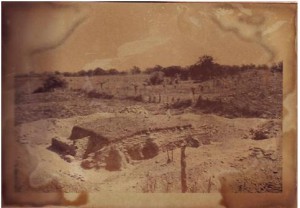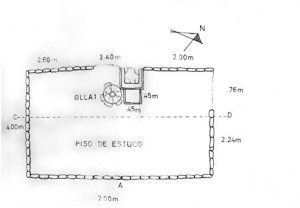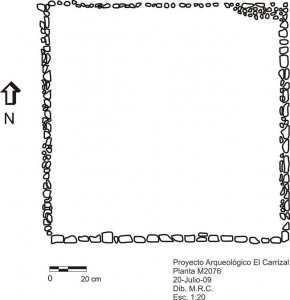There is a common mistake or misconception among students about considering only one issue about architecture when relating it to archaeology: the construction techniques. Although this topic is of great relevance, architecture can contribute to archaeology in other ways, for example through the study of formal arrangement of buildings and settlement patterns. Both disciplines take into account the way societies organized and transformed landscape, topography, and the general environment. Formal arrangements are the way buildings were distributed, while settlement patterns studies deals with the general overview of the settlement distribution. Hence, archaeology and architecture both concern broad traditions, thoughts, and ideas of the ancient peoples.
During her excavations at El Carrizal in 1961 and 1962, Bertha Cuevas had the chance to liberate (that is the technical term for uncover) a complete mound (54). Her work showed that carrizaleños were highly skilled builders, who used local resources (such as calcareous stone) for construction. They prepared the stone as big bricks creating walls arranged in squares. They filled these squares with a mixture of soil, ceramic fragments, and small rocks. The squares had stucco floors.
During our survey, we detected that all the buildings are quadrangular. We also found a couple of structures that allowed us to compare the construction techniques with the ones found by Cuevas. Preliminary results seem to indicate that this tradition was started during the Formative and continued through the Classic.
Apart from that, we have done some interpretations regarding the formal arrangement of the buildings at El Carrizal. Generally speaking, we could say that they placed their houses and civic-ceremonial structures in lines oriented West-East. This W-E pattern is present in the majority of the occupation we have reported through the 13.2 square kilometer area of our research. Moreover, the W-E tradition is unlike the Gulf Lowlands pattern, which has a North-South base. These issues arouse many questions: Is the way people arrange their settlements and indicator of social structures and religious conceptions? Or is it a combination of these factors with the regional geographic features? We’ll have to face all these questions are challenges during the next surveys and excavations.





Hey, great stuff, I have book marked your page 😉
Great post! Those names look spanish, where does this investigation is being done?